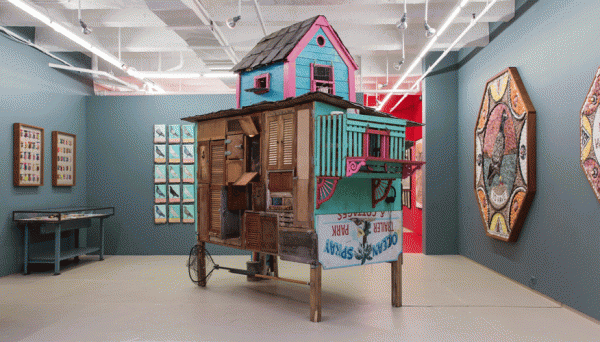
Duke Riley, “Pigeon Coop,” reclaimed wood, roofing, and construction materials, 2012-13 (photo courtesy Magnan Metz Gallery)
Magnan Metz Gallery
521 West 26th St. between Tenth & Eleventh Aves.
Extended through January 25, free, 10:00 am – 6:00 pm
212-244-2344
www.magnanmetz.com
www.dukeriley.info
There are only a few more days left to see Duke Riley’s intensely fascinating “See You at the Finish Line” as it races toward its twice-extended conclusion on Saturday. The fourth solo exhibition by the Boston-born, Brooklyn-based multimedia installation artist is divided into two parts, both filled with exacting details and, well, flights of fancy. In “Trading with the Enemy,” Riley investigates the relationship between Cuba and Key West, which includes smuggling because of the continued U.S. embargo. After four years of planning, Riley bred and trained fifty homing pigeons for eight months in a Key West loft. The pigeons, with tiny cameras attached to them, were released, with some eventually returning to their home coop bearing Cohiba cigars. He named the birds after such smugglers as Jean Lafitte, Whitey Bulger, Billy Hayes, Margaret Sanger, and Pablo Escobar and such controversial filmmakers as Mel Gibson and Larry Clark and reports which ones survived and which ones didn’t. The display includes such elements as the cigars that were brought across the Atlantic, the harnesses the pigeons wore, and the date and cause of death of those that died. Riley has transplanted the entire pigeon coop to the middle of the gallery, an astonishing piece, still an active home to several of the live birds who successfully made the journey. A trio of mosaics made out of found seashells and wood proclaim, “To Have,” “To Have Not,” and “Forget Me Not When Far Away,” while the trip is also documented in the three-channel video See You at the Finish Line, consisting of footage shot by several pigeons equipped with the cameras. It’s hysterical to see how one family responds when a pigeon lands on its boat.
In a back room, visitors can immerse themselves in “The Rematch,” in which Riley restaged the mythological Chinese race that established the zodiac and the measurement of time in a yearly cycle, a race that was won by a cheating rat. Riley went to the Caogang River in Zhujiajiao, China, where a dozen gondolas with live animals, a person wearing an animal mask, and an opera singer performing a song told from the animal’s perspective raced to the Fengshang Bridge, passing by areas where new development has displaced long-standing communities. The exhibit includes video footage of the race, the masks with the legends behind them, the songs, and raffle tickets spread over the floor. Among the songs are the Rabbit’s “I’ve Been Walking Around for 500 Years Depressed with a Broken Nose,” the Rat’s “How Dare They Question My Title,” and the Goat’s “I Probably Would Have Done Something Irresponsible with the Prize.” The exhibit seemingly explores the nature of legend, but Riley explains, “No calendars will be reset at the finish line nor will any closer understanding of that mythical day be realized. The only realization will be a brief moment of divine absurdity between two shores.” Both “The Rematch” and “Trading with the Enemy” deal with animals, history, contemporary issues, and water, a regular theme of Riley’s, displayed as only Riley can, examined from multiple angles through a variety of media. As he says in his artist statement, “I combine populist myths and reinvented historical obscurities with contemporary social dilemmas, connecting past and present, drawing attention to unsolved issues. Throughout my projects I profile the space where water meets the land, traditionally marking the periphery of urban society, what lies beyond rigid moral constructs, a sense of danger and possibility.” In “See You at the Finish Line,” Riley has created another endlessly intriguing, imaginative, and entertaining exhibit, one that requires lengthy attention but is well worth the time.